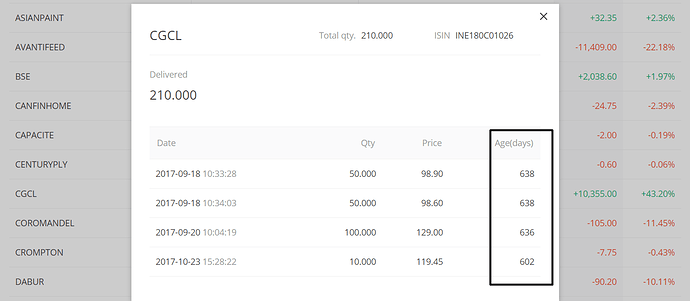As per Income Tax Department Circular: No. 704, dated 28-4-1995, the date of purchase of securities is used -
22. Instructions regarding determination of the ‘date of transfer’ and holding period for purposes of capital gains qua transactions in securities
1. Under the provisions of clause (42A) of section 2 of the Income-tax Act, 1961, the shares held in a company or any other security listed in a recognised stock exchange in India or units of the Unit Trust of India or units of a mutual fund specified under section 10(23D) shall be regarded as short-term capital assets if they are held by an assessee for not more than 12 months immediately preceding the date of its transfer. Clarifications have been sought as to which date should be regarded as the date of transfer and also about the date from which the holding period of the securities should be reckoned. Clarifications have also been sought as to how the holding periods will be computed for the purposes of capital gains when the securities, purchased in several lots at different points of time and which are taken delivery of in one lot, are subsequently sold in parts and no correlation of the dates of purchase and sale is available.
2. When the securities are transacted through stock exchanges, it is the established procedure that the brokers first enter into contracts for purchase/sale of securities and thereafter, follow it up with delivery of shares, accompanied by transfer deeds duly signed by the registered holders. The seller is entitled to receive the consideration agreed to as on the date of contract. The Board are of the opinion that it is the date of broker’s note that should be treated as the date of transfer in cases of sale transactions of securities provided such transactions are followed up by delivery of shares and also the transfer deeds. Similarly, in respect of the purchasers of the securities, the holding period shall be reckoned from the date of the broker’s note for purchase on behalf of the investors. In case the transactions take place directly between the parties and not through stock exchanges the date of contract of sale as declared by the parties shall be treated as the date of transfer provided it is followed up by actual delivery of shares and the transfer deeds.
3. As regards the second issue, where securities are acquired in several lots at different points of time, the First-in-first-out (FIFO) method shall be adopted to reckon the period of the holding of the security, in cases where the dates of purchase and sale could not be correlated through specific numbers of the scrips. In other words, the assets acquired last will be taken to be remaining with the assessee while assets acquired first will be treated as sold. Indexation, wherever applicable, for long-term assets will be regulated on the basis of the holding period determined in this manner.
Circular: No. 704, dated 28-4-1995.
This has been confirmed via ITAT rulings as well -
Also, you don’t need to manually calculate this as Console does this automatically -

